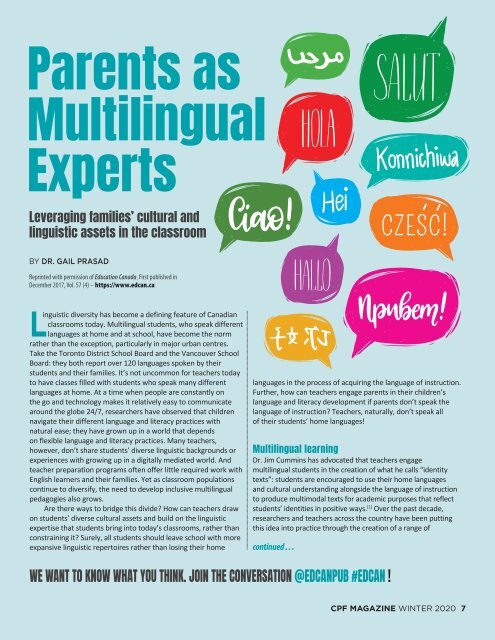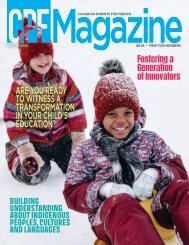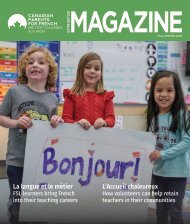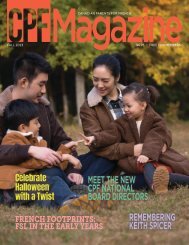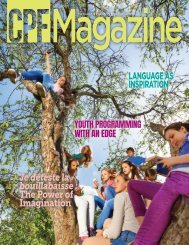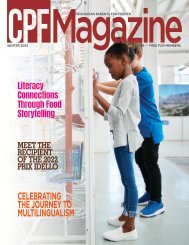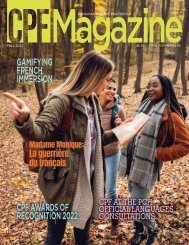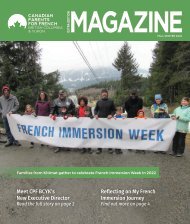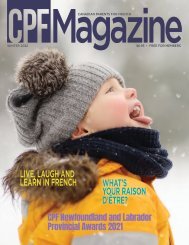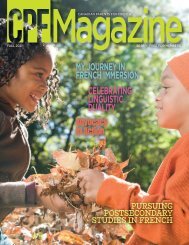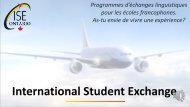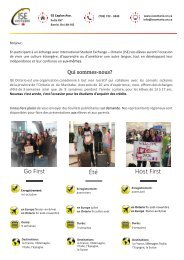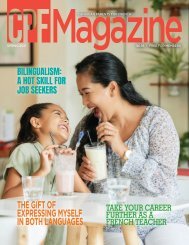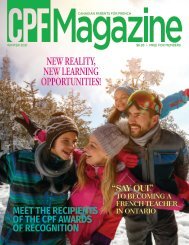CPF Magazine Winter 2020 Issue
A national network of volunteers, parents and stakeholders who value French as an integral part of Canada. CPF Magazine is dedicated to the promotion and creation of French-second-language learning opportunities for young Canadians.
A national network of volunteers, parents and stakeholders who value French as an integral part of Canada. CPF Magazine is dedicated to the promotion and creation of French-second-language learning opportunities for young Canadians.
You also want an ePaper? Increase the reach of your titles
YUMPU automatically turns print PDFs into web optimized ePapers that Google loves.
Parents as<br />
Multilingual<br />
Experts<br />
Leveraging families’ cultural and<br />
linguistic assets in the classroom<br />
BY DR. GAIL PRASAD<br />
Reprinted with permission of Education Canada. First published in<br />
December 2017, Vol. 57 (4) – https://www.edcan.ca<br />
Linguistic diversity has become a defining feature of Canadian<br />
classrooms today. Multilingual students, who speak different<br />
languages at home and at school, have become the norm<br />
rather than the exception, particularly in major urban centres.<br />
Take the Toronto District School Board and the Vancouver School<br />
Board: they both report over 120 languages spoken by their<br />
students and their families. It’s not uncommon for teachers today<br />
to have classes filled with students who speak many different<br />
languages at home. At a time when people are constantly on<br />
the go and technology makes it relatively easy to communicate<br />
around the globe 24/7, researchers have observed that children<br />
navigate their different language and literacy practices with<br />
natural ease; they have grown up in a world that depends<br />
on flexible language and literacy practices. Many teachers,<br />
however, don’t share students’ diverse linguistic backgrounds or<br />
experiences with growing up in a digitally mediated world. And<br />
teacher preparation programs often offer little required work with<br />
English learners and their families. Yet as classroom populations<br />
continue to diversify, the need to develop inclusive multilingual<br />
pedagogies also grows.<br />
Are there ways to bridge this divide? How can teachers draw<br />
on students’ diverse cultural assets and build on the linguistic<br />
expertise that students bring into today’s classrooms, rather than<br />
constraining it? Surely, all students should leave school with more<br />
expansive linguistic repertoires rather than losing their home<br />
languages in the process of acquiring the language of instruction.<br />
Further, how can teachers engage parents in their children’s<br />
language and literacy development if parents don’t speak the<br />
language of instruction? Teachers, naturally, don’t speak all<br />
of their students’ home languages!<br />
Multilingual learning<br />
Dr. Jim Cummins has advocated that teachers engage<br />
multilingual students in the creation of what he calls “identity<br />
texts”: students are encouraged to use their home languages<br />
and cultural understanding alongside the language of instruction<br />
to produce multimodal texts for academic purposes that reflect<br />
students’ identities in positive ways. [1] Over the past decade,<br />
researchers and teachers across the country have been putting<br />
this idea into practice through the creation of a range of<br />
continued . . .<br />
WE WANT TO KNOW WHAT YOU THINK. JOIN THE CONVERSATION @EDCANPUB #EDCAN !<br />
<strong>CPF</strong> MAGAZINE WINTER <strong>2020</strong> 7


